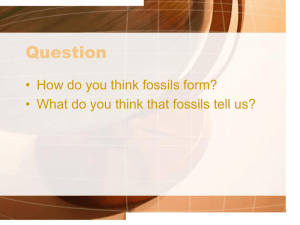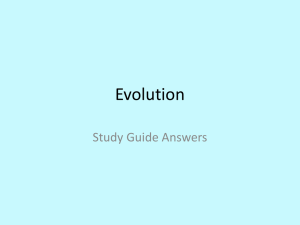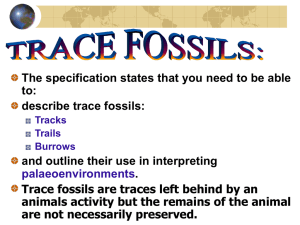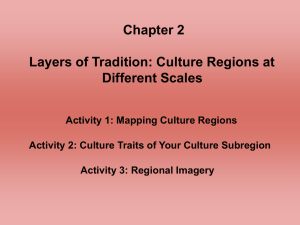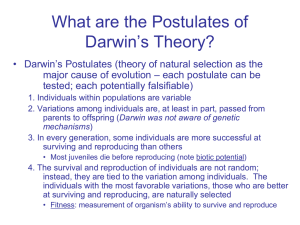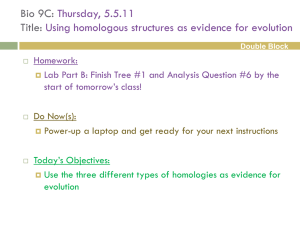Evolution
advertisement
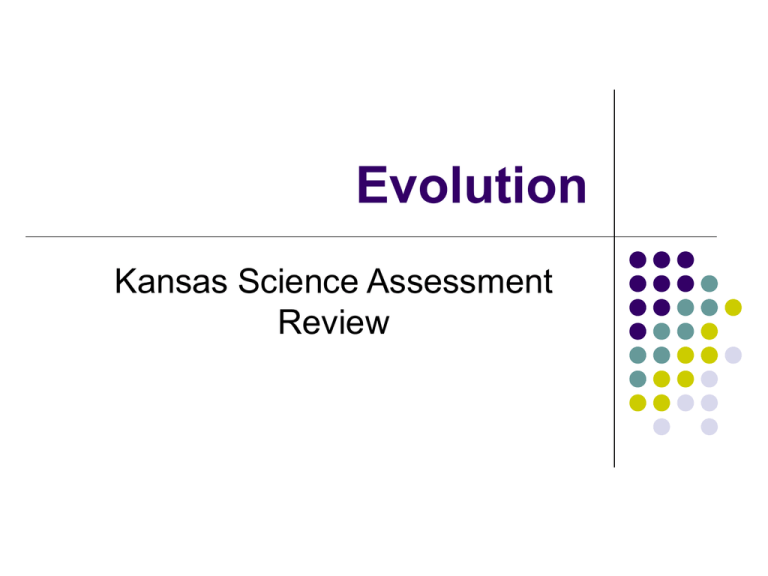
Evolution Kansas Science Assessment Review Can you think of something that doesn’t change? Did you think of the amount of energy in the universe? Very intuitive! It is safe to say that most things do change. Is it then safe to say that life forms change… Tiktaalik-Fish or Amphibian? Is this organism a fish or an amphibian? Tiktaalik Lived 375 million years ago Found in Canada in 2004 Intermediate between fish and tetrapods Scales and fins like fish Flat head with eyes on top like amphibians Archaeopteryx- Bird or Dino? Is this a bird or a dinosaur? Archaeopteryx Lived 155-150 million years ago Intermediate between reptiles and birds Long bony tail, beak with teeth, and claws like a reptile Feathers and skeletal features like birds Four Winged Dinosaur Another transitional Fossil- Microraptor Warm Blooded Dinosaurs In both breathing systems, air passes through the lungs twice, increasing metabolism and making the dinosaurs warm-blooded rather than cold-blooded Evidence for Evolution There are transitional fossils Found in rock layers with oldest at the bottom and newer fossils at the top Evidence of Evolution The Fossil Record Huge amount of diversity among fossils Observable similarities and differences among fossils and living organisms Homologous structures Genetics and Evolution Genetics provided a vast amount of evidence for evolution DNA comparisons are also used Life is Very Old Bacteria-like life existed billions of years ago 3.5 billion years ago forms like this existed Stromatolites in Australia formed by Cyanobacteria Can you observe evolution? Bacteria have been used because of their short life cycle Resistance to multiple antibiotics Methicillin Resistant Staphylococcus Aureus What is Evolution? Changes in life forms over time Fuel of evolution Variation Selection Time Two main points: Natural Selection Descent with Modification Phylogenetic Tree or Cladograms Used to demonstrate relationships between species Lamarck One of the first hypotheses of evolution Acquired Characteristics Giraffes could stretch their necks to get food and make their necks longer This long neck could be passed on to offspring Body Builders do not pass on their muscles to their kids. Natural Selection Survival of the Fittest Variation exists in every species There are not enough resources for every individual to survive Some variations allow organisms to take advantage of resources These organisms survive and reproduce, passing on their variations Natural Selection Each species has adapted to its environment and fills a niche Environmental niche- the position or function of a species in a community Some insects are only capable of pollinating one type of flower Natural Selection & Speciation Can happen due to geographic isolation Darwin’s finches- isolated on islands Natural Selection- Reproductive Temporal reproductive isolation Some cicadas have a 13 or 17 year life cycle This life cycle has not been “figured out” by the predators Populations Evolve Populations evolve, not individuals Natural Selection is usually a slow process Lamarck didn’t know the whole story Nature will select the favorable traits and the population will adapt to their environment. evolve evolve Artificial Selection Humans select the favorable traits Breed organisms that have those traits Dogs are a great example All dogs are the same species Humans have bred certain qualities into dogs for different purposes Bloodhounds for hunting Greyhounds for running Where does variation come from? Gene Mutations Crossing Over Independent Assortment Fertilization (Mom + Dad= Kid) Variations can be passed on to offspring Mutations Most mutations are neutral Most of DNA is made of introns (non-coding) However, standards say that most are harmful. (They are wrong) If the mutation happens in a coding region, then it is usually harmful Some are beneficial for that environment and lead to selection Mutations Think of your watch If I randomly took a part out of my watch would it most likely be bad or good for my watch? Most likely bad Genetic Drift Random change in allele frequencies Founder effect and Bottleneck A very small amount of individuals become isolated The population will have the alleles that these founders had Increased chance of a damaging allele being “fixed” Group becomes isolated Cheetahs-Bottleneck Habitat Destruction caused a high number of cheetahs to die Some of the ones that were left had a damaging allele causing infertility Inbreeding of these cheetahs decreased variation One outbreak of a disease could kill them all Extinction Happens when species can’t adapt fast enough or at all Beneficial traits change when environments change When a species’ heritable traits don’t change then the species will become extinct Extinction Caused by mostly natural events Not always related to human activities but it can be Extinction 99.9% of species that ever lived are extinct! Examples of extinct species Questions 1. Tiktaalik and Archaeopteryx are: A. Examples of transitional fossils B. Extinct dinosaur fossils C. Extinct tetrapod fossils D. Warm Blooded fossils Questions 2. Evidences for evolution include (mark all that apply) A. Fossils in rock layers B. DNA and genetics C. Huge diversity in living things D. Homologous Structures E. Species currently going extinct Questions 3. Lamarck proposed which of the following to explain how animals changed? A. Acquired characteristics B. Stretching of giraffes necks caused them to become longer. C. Natural Selection D. Artificial Selection E. Survival of the fittest Questions 4. Natural Selection includes (mark all that apply) A. Variation among a species B. A specie’s desire to change C. Characteristics that can be inherited D. Competition for resources Answers 1. A 2. All of the above 3. A, B 4. A, C, D Questions 5. Which of these groups is the smallest unit to evolve? A. Individuals B. Phyla C. Populations D. Kingdoms Questions 6. Mutations within a DNA sequence are A. Natural processes that produce genetic diversity B. Natural processes that always affect the phenotype C. Unnatural processes that always affect the phenotype D. Unnatural processes that are harmful to genetic diversity Questions 7. Which of these best illustrates natural selection? A. An organism with favorable genetic variations will tend to survive and breed successfully. B. A population monopolizes all of the resources in its habitat, forcing other species to migrate. C. A community whose members work together utilizes all existing resources and migratory routes. D. The largest organisms in a species receive the only breeding opportunities. Questions 8. A species of finch has been studied on one of the geographically isolated Galapagos Islands for many years. Since the island is small, the lineage of every bird for several generations is known. This allows a family tree of each bird to be developed. Some family groups have survived and other have died out. The groups that survive probably have A. interbred with other species B. inherited some advantageous variations C. found new places on the island to live D. been attacked by more predators Answers 5. C 6. A 7. A 8. B Questions 9. Earth has undergone some catastrophic changes from time to time. Which of these most likely explains why life on Earth continued following these catastrophes? A. Dominant species had a slow mutation rate. B. Many species filled the same niche. C. A strong species had many different characteristics. D. A wide diversity of species existed. Questions 10. A small population of chimpanzees lives in a habitat that undergoes no changes for a long period. How will genetic drift probably affect this population? A. It will accelerate the appearance of new traits. B. It will promote the survival of chimpanzees with beneficial traits. C. It will increase the number of alleles for specific traits. D. It will reduce genetic diversity. Questions 11. A single species of squirrel evolved over time into two species, each on opposite sides of the Grand Canyon. This change was most likely due to A. higher mutation rates on one side. B. low genetic diversity in the initial population. C. the isolation of the two groups. D. differences in reproductive rates. Questions 12. Fossil evidence suggests that a number of members of one fish species from an ancient lake in Death Valley, California, became several isolated species. Which of the following best explains the cause of this speciation? A. episodic isolation B. temporal isolation C. geographic isolation D. behavioral isolation Questions 13. If a paleontologist finds fossils of many different species existing in the same area at approximately the same time, the paleontologist can conclude that the ecosystem in this area had a high degree of A. climatic variation B. episodic speciation C. biological diversity D. geographic isolation Answers 9. D 10. D 11. C 12. C 13. C



